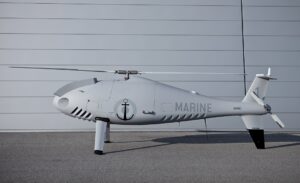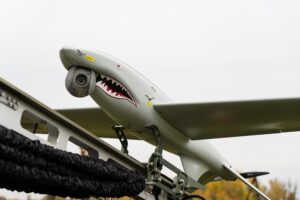The consumer drone world has three new hand-launch drones to pick from — all of which were announced in the past two weeks.
At the end of August 2024, ZeroZero Robotics announced the HOVERAir X1 PRO and HOVERAir X1 PROMAX. Both are upgraded versions of the older model, the HoverAir X1. (For now, they’re not actually shipping — just available for pre-order).
And a couple weeks later — in early September — DJI announced the Neo drone. Like the HOVERAir drones, Neo is also not yet shipping in the U.S. at least. Though it’s already shipping in other countries, it’s only around now for pre-order. Neo is set to ship Oct. 6.
The drones have some similarities. Both are hand-launch style, with an emphasis on selfie flying. Additionally, both are made by Chinese drone companies. And perhapps most critically? Both are ultra-lightweight, coming in well below the critical sub-250-gram drone weight. That exempts them from many types of regulation.
But beyond that, they’re actually fairly different. DJI Neo is the cheapest of the bunch. And sure, DJI has a tendency to undercut the competition, but a big factor in the lower price tag is that Neo has (for the most part) inferior specs relative to the HOVERAir X1 offerings.
I’ve extensively covered the best, affordable DJI drones across my site already, so I’ll spare you the comparisons between DJI Neo versus other DJI drones.
But given their hand-launch similarities, Neo and the HOVERAir X1 drones have left shoppers wondering which of these sets of drones are best. With that, here’s a comparison between DJI versus the HOVERAir X1 lineup, which includes the HOVERAir X1 PROMAX, HOVERAir X1 PRO and HOVERAir X1 drones:
DJI Neo versus HOVERAir X1 drones: how to choose
All four hand-launch drones, compared
Here’s a look at these four drones at a glance:
| | DJI Neo | HOVERAir X1 | HOVERAir X1 PRO | HOVERAir X1 PROMAX |
| Use Case | Selfies, people who want to fly indoors, casual users | Selfies, people who want to fly indoors, casual users | Sports like cycling or snow sports | Professional video where image quality is key, and filming in complex environments |
| MSRP | From $199 | From $349 | From $499 | From $699 |
| Video Resolution | 4K/30 fps | 2.7K@30fps 1080P@60fps | 4K@60fps 1080P@120fps (Slo-mo) | 8K@30fps 4K@120fps | 10-bit HLG |
| Active collision detection | – | – | Active rear-side collision detection (Proximity sensor) |
Vision-based rear-side collision detection |
| Weight | 165 grams | 125 grams | 191.5 grams | 192.5 grams |
| Dimensions (LxWxH) | 130×157×48.5 mm | 127×86×31 mm | 149×105×34 mm | 149×105×34 mm |
| Max follow speed | 21.6 km/h (normal mode) | 25 km/h | 42 km/h | 42 km/h |
| Transmission distance | 50 meters (effective operating range) | 30 meters (phone app) | 500 meters (phone app) or 1 km (beacon controller) | 500 meters (phone app) or 1 km (beacon controller) |
| Max flight time | 18 minutes | 11.5 minutes | 16 minutes | 16 minutes |
| Wind resistance | Level 4 (8 m/s) | Level 4 (7.9 m/s) | Level 5 (10.7 m/s) | Level 5 (10.7 m/s) |
Key differences between DJI Neo versus HoverAir X1 drones
I’ve dug deep into these drones on their own on separate pages. Check out my ultimate guide to the DJI Neo and my guide to the new HOVERAir X1 PRO and PROMAX drones.
Since the DJI Neo isn’t out yet, that guide is fully based on specs. I did get to fly the HOVERAir X1 PRO and PROMAX drones, though it was at a press event where I flew in a semi-controlled environment. Drone Girl staff writer did fully, personal review the original HoverAir X1 drone, which is extensive and critical.
With that in mind, here are some major standout differences — and my pick for the winner based on each spec:
Outdoor flying
Winner: HOVERAir X1 PRO and HOVERAir X1 PROMAX
Both of these two drones have Level 5 windspeed resistance, versus Level 4 on the other two. That’s the difference between flying in a breeze (Level 5), and ideally avoiding even light breezes (Level 4).
Of course neither of them is something you’d want to fly in any sort of significant weather. You’ll need a more powerful drone for that. For example, the DJI Air 3 is even stronger at Level 6 (and plenty of enterprise-oriented drones can even fly in outright storms.
Additionally, the HOVERAir X1 PRO and HOVERAir X1 PROMAX are designed to fly as far as 500 meters (or about a third of a mile). You won’t be flying these drones super far out. Again, plenty of other camera drones can go much farther.
But compare that to the Neo or HOVERAir X1, which only fly 50 and 30 meters, respectively. 50 meters is about as tall as The Arc de Triomphe in Paris, France. You might use it to fly over some shorter buildings, but don’t send this on too far out. Otherwise, it’ll automatically return to home.
Video quality
Winner: HOVERAir X1 PROMAX
This is the only one of the bunch that films in 8K. Of course, it’s the most expensive. Happily, the DJI Neo and HOVERAir X1 PRO are still capable of 4K. That’s more than sufficient for most use cases. The only drone of this bunch to skip, assuming you care about video quality, is the HOVERAir X1. Alas, it only films at 2.7K.
Check out some video I shot using the PROMAX on my Instagram (shared below):
Quality of drone hardware and overall ease of use
I’ll preface this by saying I haven’t gotten my hands on the DJI Neo itself (yet). It doesn’t ship in the U.S. until October, alas! But I will say this: I had a few issues with the HoverAir X1 drones even during the press preview. We also encountered issues during our personal HoverAir X1 drone review.
For example, the HoverAir X1 controller was both cheaply made and not intuitive to use. I actually broke a piece of it off when I tried to transform it from the triple to the double piece size. I also encountered issues with the follow-me tech, where the drone couldn’t latch onto me. Once, it latched onto someone else behind me, and then proceeded to zoom right past my head (nearly clipping my face) as it tried to follow that person.
Now I have not flown the DJI Neo itself, but based on my past history of reviewing dozens of DJI drones myself, the DJI user experience is generally quite seamless. I’ve rarely had issues with build quality, and I’ve rarely broken DJI drones — even after crashing them into trees (yes, it happens to me too). The whole experience from start to finish is intuitive, all the way from takeoff to editing in the DJI app. I anticipate DJI will take its years of learnings from previous, powerhouse drones (including their enterprise aircraft like the Matrice series) all the way to other, unique consumer drones like the Cinewhoop-style Avata 2 FPV drone. It’ll them pour knowledge from building those drones into making sure that Neo is sold — all despite its $200 price tag.
Neo versus HOVERAir: who is each type of drone best for?
With that breakdown of critical specs, let’s dive into each type of drone. We’ll also uncover what type of person would most benefit from it.
DJI Neo: you want a reliable yet super cheap drone for taking selfies
At just $199, it’s tough to go wrong with DJI Neo. It works outside, and can fly a few stories high. But generally speaking, this is a tool for vloggers or content creators. Gather unique angles as the either follows you, or flies in pre-programmed flight modes (like making a circle around you).
The 4K video quality is still excellent, making it good to shoot content for your YouTube channel. And, it does offer upgrade options. That includes the chance to pair it with a remote controller (that would be the FPV Remote Controller 3), should you prefer to control your flight more seriously.
With more than 10 years of experience in making a wide range of affordable, consumer drones (and absolutely dominating the market in doing so), DJI Neo is a drone from a reliable, high-quality drone company.
- Buy DJI Neo now from Adorama for $199.
- Buy DJI Neo now from Amazon for $199.
- Buy DJI Neo now from B&H Photo for $199.
- Buy DJI Neo now from Drone Nerds for $199.
HOVERAir X1: you want an affordable alternative to DJI

There’s basically one reason to select the HOVERAir X1 at this point: it’s not a DJI drone. There are all sorts of reasons why consumers want a DJI alternative. Some folks prefer drones made in America (which this one is not, as it’s also made in China). But DJI alternatives also appeal to people seeking to minimize what’s largely considered a DJI monopoly. Some pilots just want something new to stand out from the crowd.
The HOVERAir X1 checks both of those last two boxes. However, its specs are inferior to DJI Neo on almost every level — plus it’s more expensive. If you do want to check those last two boxes, you might as well pay more for either the HOVERAir X1 PRO or HOVERAir X1 PROMAX. That way you’ll at least have superior specs to the DJI Neo.
- Buy the HOVERAir X1 now directly from ZeroZero Robotics.
- Buy the HOVERAir X1 now directly from Amazon.
HOVERAir X1 PRO: you want the PROMAX, but are on a tight budget

The HOVERAir X1 PRO packs on way more features that the DJI Neo doesn’t offer. Sure, it’s more than twice the price, but it may be worth it.
It’s more powerful in outdoor flight, and it can fly farther distances, unlocking the ability to shoot more landscape photos or wider shots of cities than you could with Neo. Active rear-side collision detection also makes it a bit safer to fly than Neo.
HOVERAir X1 PROMAX: you want the most powerful (yet portable and compact) drone you can get

If you were willing to pay double the price to get the HOVERAir X1 PRO versus DJI Neo, you might as well spring the extra $200 for the PROMAX version. Trust me, it’s worth it.
8K video on the PROMAX versus just 4K on the PRO is killer. More importantly, given my emphasis on safety, is the smarter collision detection. Whereas the PRO has just active rear-side collision detection, the PROMAX has vision-based rear-side collision detection, which effectively means smarter tech inside the PROMAX version. Consider $200 more for much more than that in terms of your peace of mind.
Just be cognizant of total cost. Sure, its starting price is $700. Bu what if you really want all the bells and whistles? Let’s say you want your own controller for better, manual flight, or you just want to spring for some ND filters to get higher-quality images. If so, expect to pay something more in the $1,000 ballpark.
Then again, once your budget is that high, you might very well consider one of the other great camera drones on the market. Of course, the HOVERAir X1 PROMAX offers the ultra-small size and hand-launch (which is actively discouraged with most other camera drones). But before making any drone purchase, nail down your priorities.
If super compact size is critical — and you’re not interested in manual flight but would rather have the drone do the work in taking your selfies — then the HOVERAir X1 PROMAX is your best bet.
The post DJI Neo versus HOVERAir X1: which hand-launch drone is best? appeared first on The Drone Girl.







